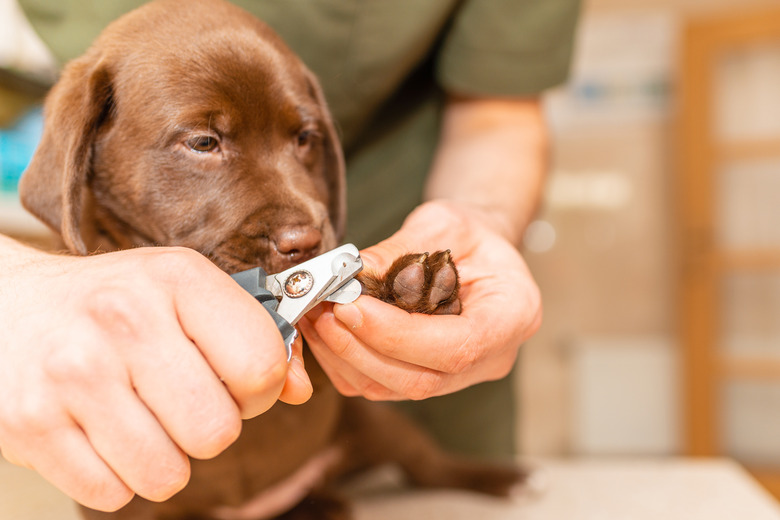Can I Tell How Big My Puppy Will Get From Its Paws?
Everyone loves puppies, with their tiny little paws and oversized eyes. Their clumsy, playful antics charm us to no end, even when we get frustrated with their chewing and potty-training accidents. But puppies don't stay puppies forever, and eventually, your baby dog will become a full-size pooch. If you want to know how big your new pet will be when they grow up, the paws may give you a clue, but you'll need other information to get a solid idea of their adult size.
Using puppy paws to guess size
Using puppy paws to guess size
Can you tell how big your little puppy will grow up to be based on the feet? Not accurately, but it can be a fun way to guess. Essentially, if your pup has had a bit of a growth spurt and the feet are bigger than the rest of the body, you can estimate that your dog will grow into the size of their feet. So, if your puppy has big paws and is a Saint Bernard, for example, but your dog is still pretty small, the dog will probably grow to be the size of a Saint Bernard eventually.
You can look up a puppy paw size chart. Of course, it's worth remembering that some breeds have particularly large or small paws for their size. Collies have notably dainty feet, and bulldogs may be short, but they have pretty big paws to carry all that weight.
Guessing your pup's eventual size based on parents
Guessing your pup's eventual size based on parents
If you know what breed your dog is, this can make accurately guessing their eventual size a lot easier. You can simply look up a breed guide and see how much dogs of that breed usually weigh. Remember to keep in mind that male and female dogs have different average weights in many breeds, and there are some dogs who look like puppies forever. If you have a mixed-breed dog or a dog of unknown origin, this method is unreliable without a DNA test.
Even if you're dealing with a mixed-breed dog with two mixed-breed parents, the parents can give you some indication of the size. If they're both about the same size, your puppy will probably grow up to be about the same size as well. If they're different sizes, your pup will probably grow to somewhere between the two parents' sizes. Unfortunately, if they're drastically different sizes or if you haven't seen the parents, it can still be difficult to guess your dog's eventual size.
How big will my puppy get based on weight?
How big will my puppy get based on weight?
One way to guess your dog's eventual weight is by using a puppy weight chart online. To do this, you'll need to at least know what your pup's weight is at 6 weeks of age for a small or toy breed, 14 weeks of age for a medium breed, or 6 months of age for a large breed. This is because pups tend to gain weight at a predictable rate but at different speeds depending on their size.
If you have a small-breed or toy-breed dog, multiply the 6-week weight by 4 and you'll have their adult weight. For example, a small-breed dog who is 1 pound at six weeks should weigh around 4 pounds as an adult. For medium-breed dogs, you'll need to multiply the dog's weight at 14 weeks old by 2.5. For example, a medium-breed pup who weighs 20 pounds at 14 weeks will grow to be around 50 pounds. For large- and giant-breed dogs, you'll need to multiply the dog's weight at 6 months by 2. For example a giant-breed puppy that weighs 60 pounds at 6 months will grow up to be around 120 pounds.
If you don't know your dog's weight at 6 weeks, 14 weeks, or 6 months of age or if you really have no idea whether you have a small-, or medium-, or large-breed dog, you can figure out the average rate of growth per week and use that to estimate your dog's weight at the end of a year. To do this, you need to divide your dog's current weight by their age in weeks to get the average weight by week and then multiply that by 52 for the number of weeks in a year. So, if your dog is 10 weeks old and weighs 10 pounds, then you can estimate that they will weigh 52 pounds as an adult (10 pounds divided by 10 weeks multiplied by 52).
Why does knowing how big my puppy will get matter?
Why does knowing how big my puppy will get matter?
Some puppy parents wonder if it really matters if they know how big their little pups will be when they grow up, and some even like to wait and see rather than do the legwork to estimate the dog's eventual size. The truth is that it will matter a lot more to some people than others.
If you have a big home with a large yard and don't plan to crate train your pooch, it won't matter as much. But if you want to plan for your pup so that you can do things like crate train without having to buy a dozen crates while your pooch grows, you'll probably want to have at least some idea of how big your dog will be.
One very important reason to have an idea of size is because adult weight should be considered when planning to spay or neuter a dog. New research studies have started reporting that it is healthier for large-breed dogs to be spayed or neutered after 12 months of age. Waiting until their growth plates have closed helps to reduce the risk of certain types of orthopedic problems and cancer.


